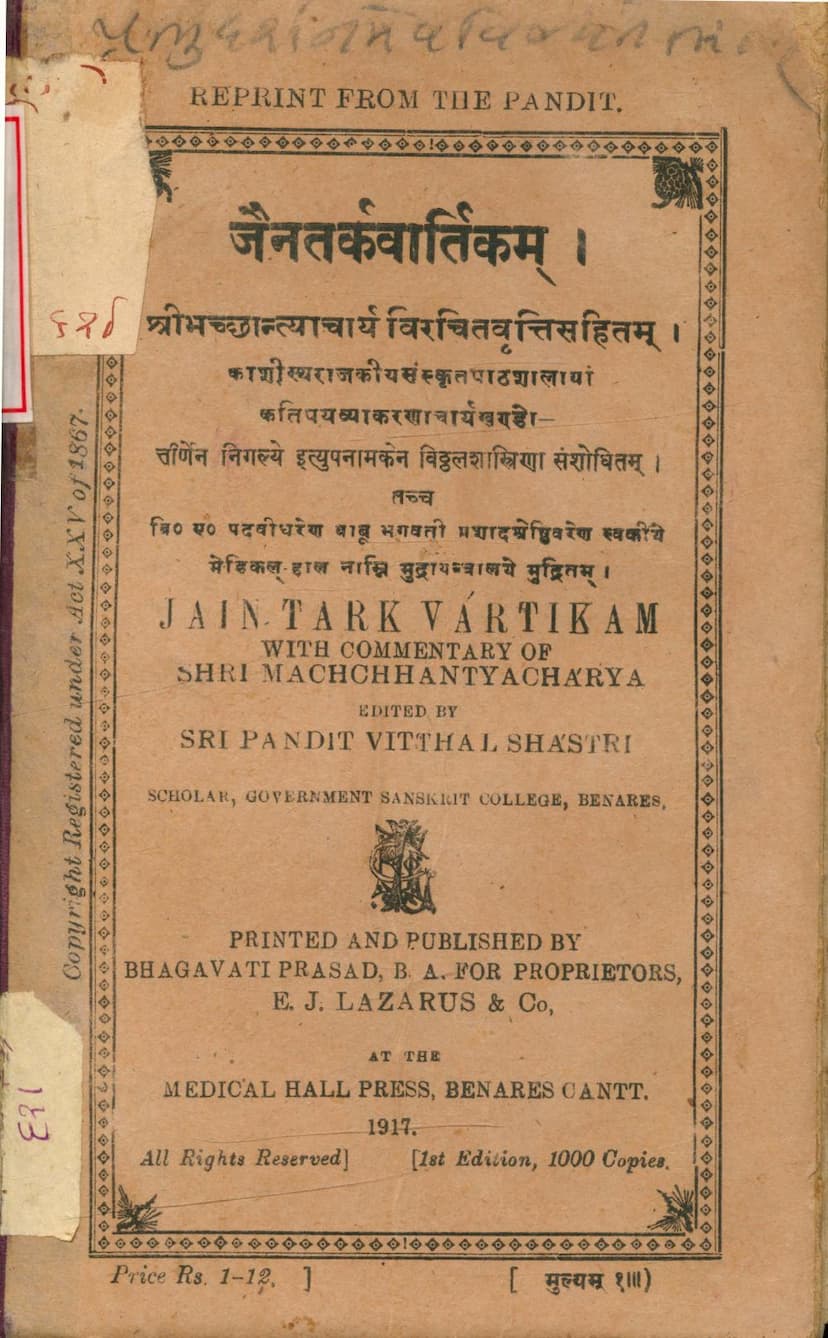Jain Tark Vartikam
Added to library: September 2, 2025

Summary
Here's a comprehensive summary of the Jain text "Jain Tark Vartikam" by Vitthal Shastri, based on the provided pages:
Book Title: Jain Tark Vartikam (जैनतर्कवार्तिकम्) Author: Vitthal Shastri (विठ्ठलशास्त्रिण) Commentary: Shri Machchhantyacharya (श्रीभच्छान्त्याचार्य) Publisher: Bhagavati Prasad (बाबू भगवती प्रसाद श्रेष्ठिवरेण) Publication Year: 1917 (1917) Copyright Registered: Act XXV of 1867 Edition: 1st Edition, 1000 Copies Price: Rs. 1-12
Overall Purpose and Content:
"Jain Tark Vartikam" is a significant Jain philosophical text that meticulously elaborates on the principles of Jain logic and epistemology. It serves as a commentary on the foundational sutras (aphorisms) composed by Acharya Siddhasena Divakara. The text aims to present and defend the Jain perspective on various philosophical concepts, often by critiquing and refuting the viewpoints of other contemporary philosophical schools, particularly the Nyaya and Mimamsa traditions.
Structure and Key Themes:
The book is structured into four main sections (Paricchedas):
-
Sādhāraṇa Lakṣaṇa (सामान्य लक्षण - General Characteristics): This section establishes the foundational principles of Jain knowledge. It critiques the Nyaya school's concept of sannikarsha (conjunction) as a source of knowledge, arguing instead for the primacy of knowledge itself (jñāna) as the ultimate proof. It also refutes the authority of the Vedas and the concept of an omniscient creator God.
-
Prameyabheda (प्रमेयभेद - Distinction of Objects of Knowledge): This part delves into the nature of reality and knowledge. It refutes the idea of real, distinct categories of objects of knowledge, emphasizing instead the distinctions and classifications within knowledge itself. It also discusses various means of valid knowledge like anumāna (inference), arthāpatti (postulation), and anupalabdhi (non-apprehension).
-
Anumāna (अनुमान - Inference): This section focuses on the nature and validity of inferential knowledge. It critiques the concept of parārthānumāna (inference for the sake of proving to others), arguing for the sufficiency of svārthānumāna (inference for oneself). It systematically analyzes and refutes various logical fallacies, particularly the sixteen types of hetvābhāsa (fallacies of inference).
-
Āgama (आगम - Scripture/Testimony): The final section addresses the nature of scriptural authority. It defines āgama and argues for its validity, while also critiquing the claims of other scriptures, demonstrating their scriptural limitations (anṛtatva). The text emphasizes that only valid scriptural testimony, derived from omniscient beings, holds true authority.
Key Arguments and Concepts Discussed:
- Pradhānya of Knowledge: A central Jain argument presented is that knowledge itself is the primary means of knowing. Other proposed sources of knowledge are critiqued as being either dependent on or ultimately reducible to valid knowledge.
- Critique of Nyaya and Mimamsa: The author engages in rigorous debate with prominent philosophical schools, particularly the Nyaya (Buddhists and others) and Mimamsa traditions. Specific concepts like sannikarsha (conjunction), the validity of the Vedas, the existence of an omniscient God, and the nature of inference are extensively analyzed and refuted from a Jain standpoint.
- Refutation of Sannikarsha: The text challenges the Nyaya idea that direct perception arises from the contact of sense organs with objects. It argues that such contact is often impossible or insufficient to explain perception, particularly for subtle or distant objects.
- The Nature of Inference (Anumāna): The text establishes the validity of inference as a source of knowledge, but critically examines its structure and potential fallacies. The detailed refutation of hetvābhāsas highlights the Jain emphasis on precise and valid reasoning.
- Refutation of Vedic Authority and God: A significant portion of the "Sādhāraṇa Lakṣaṇa" section is dedicated to dismantling the claims of Vedic infallibility and the existence of a creator God, core tenets often supported by other Indian philosophical schools.
- Emphasis on Jain Canonical Texts: The "Āgama" section underscores the authority of Jain scriptures, implying that they possess the genuine and comprehensive understanding of reality.
- "Jain Vartikam" as Superior: The introduction (Page 4) explicitly states that "Jain Vartikam" surpasses all other works in explaining the Jain doctrine, not only by presenting Jain principles but also by effectively refuting other philosophical systems with concise arguments, making them understandable even to a beginner.
- Scholarly Rigor: The text is characterized by its depth of analysis, logical acumen, and the detailed engagement with opposing philosophical viewpoints, showcasing the intellectual prowess of Jain scholars.
- Language and Style: The text is written in Sanskrit, with a commentary provided in Sanskrit. The editing by Pandit Vitthal Shastri is highlighted as a scholarly endeavor.
Significance:
"Jain Tark Vartikam" is a crucial work for understanding the epistemological and logical foundations of Jainism. It demonstrates the sophistication of Jain philosophical thought and its ability to engage in rigorous dialectical debate with other major philosophical traditions of ancient India. The text serves as a testament to the Jain commitment to rational inquiry and the pursuit of truth through valid means of knowledge.